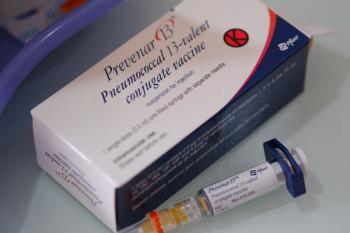
- Drug Topics July/August 2023
- Volume 167
- Issue 07
2023-2024 Flu Season: What to Expect
As the Southern Hemisphere sees a mixed flu season, uncertainty looms for those in the North.
The time to prepare is now as the 2023-2024 flu season approaches. Pharmacists play a critical role in prevention during flu season, ensuring patient health with expertise and planning in addition to vaccine administration and patient education. Experts often look to the Southern Hemisphere’s April to September flu data to estimate rates for the Northern Hemisphere. Although these data are not a guarantee, they provide useful information to prepare.
Nearly halfway through the Southern Hemisphere’s influenza season, data are a mixed bag. Other respiratory viruses, such as COVID-19 and respiratory syncytial virus, are contributing to uncertainty in predictions.
So what does this mean for our upcoming 2023-2024 flu season?
The Southern Hemisphere's Current Season
The World Health Organization’s (WHO’s) flu update1 for the first half of June 2023 reported that flu rates in some South American countries, such Brazil and Bolivia, are declining; rates are also declining in Chile after an early start to flu season in the country. Argentina is experiencing a moderate increase in flu activity, although levels have been average throughout the season.2 Uruguay and Paraguay are experiencing small rate increases as well.2
Meanwhile, Australia—which saw its worst flu season in 5 years during the 2022- 2023 season—is also experiencing rate variations among its states and territories.1-3 Overall, flu clinic visits have increased in Australia, although flu levels are typical for the season.1,2 Other Southern Hemisphere flu rate increases are being seen in Central American countries, including Panama, Guatemala, Nicaragua, El Salvador, and Honduras.1
With this large amount of variation, predicting what is coming for the Northern Hemisphere’s flu season will be difficult.
The WHO and CDC have been tracking the dominant strains in the Southern Hemisphere. “This 2023 Southern Hemisphere flu season, some Central and South America countries have early or intense influenza A (H1N1) activity, while others have typically timed seasons with a mix of influenza A (H3N2), influenza A (H1N1), and influenza B/Victoria,” the CDC reported.2
Influenza B activity seems to be increasing this year vs last year, Seema Lakdawala, PhD, associate professor of microbiology and immunology at Emory University School of Medicine in Atlanta, Georgia, said in an interview with Becker’s Hospital Review, where she also noted that one-third of Southern Hemisphere cases are influenza B strains.4
It’s still too early to tell whether the Northern Hemisphere will see similar patterns for the upcoming flu season.
Vaccine Strains
On February 24, 2023, the WHO announced its recommendations for influenza vaccine composition for the Northern Hemisphere’s 2023-2024 flu season.
For quadrivalent, egg-based vaccines, WHO recommended5:
- A/Victoria/4897/2022 (H1N1) pdm09–like virus;
- A/Darwin/9/2021 (H3N2)–like virus;
- B/Austria/1359417/2021 (B/Victoria lineage–like virus; and
- B/Phuket/3073/2013 (B/Yamagata lineage–like virus.
For quadrivalent, cell culture or recombinant-based vaccines, WHO recommended5:
- A/Wisconsin/67/2022 (H1N1) pdm09–like virus;
- A/Darwin/6/2021 (H3N2)–like virus;
- B/Austria/1359417/2021 (B/Victoria lineage)–like virus; and
- B/Phuket/3073/2013 (B/Yamagata lineage)–like virus.
For trivalent, egg-based vaccines, WHO recommended5:
- A/Victoria/4897/2022 (H1N1) pdm09–like virus;
- A/Darwin/9/2021 (H3N2)–like virus; and
- B/Austria/1359417/2021 (B/Victoria lineage)–like virus.
For trivalent, cell culture or recombinant-based vaccines, WHO recommended5:
- A/Wisconsin/67/2022 (H1N1) pdm09–like virus;
- A/Darwin/6/2021 (H3N2)–like virus; and
- B/Austria/1359417/2021 (B/Victoria lineage)–like virus.
It is too early to tell whether the selected strains for the vaccines are a good match for the Northern Hemisphere season, Lakdawala said, adding that data should be available in 1 to 2 months.4
New and Better Ways of Predicting Flu?
Other methods of predicting flu and other infectious diseases are rapidly emerging, including the use of artificial intelligence (AI). Based in Toronto, Canada, BlueDot Inc, an outbreak intelligence organization, has developed a model that combines AI with human intelligence to track influenza-like illnesses (ILI).
“We’re excited to collaborate with Microsoft and bring our global infectious disease intelligence and forecasts to its ecosystem partners,” BlueDot Founder and CEO Kamran Khan, MD, said in a news release.6 “This will empower them with the foresight to anticipate what’s coming next and make critical decisions that not only protect their business and people, but in turn contribute to a healthier, safer, and more prosperous world.” The company’s biweekly report called ILI Pulse contains infectious disease updates using information from AI and human sources.
Influences on Flu Season Severity
Many factors affect flu season severity.
Some individuals have vaccine fatigue—a result of COVID-19 vaccine campaigns—and misinformation is still widely circulating that causes people to avoid vaccination. Other circulating viruses, as well as the status of nonpharmaceutical interventions such as masking and social distancing, also affect flu rates.
Preventing a severe flu season requires an all-hands-on-deck approach, with pharmacists at the heart of such interventions. It’s important for pharmacists to share the benefits of getting a flu shot and how it works with patients and to respectfully address patient misconceptions about vaccines.
As more data become available in the coming months, pharmacists should communicate the current predictions and advocate for flu vaccination, particularly for high-risk groups. “This includes people 65 years and older, people of any age with certain chronic medical conditions (such as asthma, diabetes, or heart disease), pregnant people, and children younger than 5 years, but especially those younger than 2 years old,” according to the CDC.7 Patients older than 65 years should receive the higher-dose version of the vaccine.7
Last Season's Flu Burden and Vaccination Coverage
Early estimates by the CDC show that between 19,000 and 58,000 individuals died of influenza during the 2022-2023 season. In addition, between 300,000 between 12 and 26 million influenza-related hospital visits during the 2022-2023 season.8
The agency also reported that vaccination coverage for the 2021-2022 season was 49.4% for adults 18 years and older and 57.8% for children and adolescents aged 6 months to 17 years.9
Although experts typically can use Southern Hemisphere flu data to estimate rates for the North, this year’s variations are making predictions challenging. By advocating for vaccination and promoting preventive measures, pharmacists can help reduce the severity of the upcoming flu season to protect their patients and their communities.
References
1. Influenza update N° 448. World Health Organization. June 26, 2023. Accessed June 27, 2023. https://www.who.int/publications/m/item/influenza-update-n--448
2. CDC tracks ongoing flu activity in the Southern Hemisphere. CDC. Updated June 23, 2023. Accessed June 27, 2023. https://www.cdc.gov/flu/spotlights/2022-2023/ongoing-flu-southern-hemisphere.htm
3. Edwards E. Australia’s bad flu season is a warning for the U.S. this year. ABC News. August 4, 2022. Accessed June 27,2023. https://www.nbcnews.com/health/health-news/australia-flu-season-warning-sign-us-this-year-rcna40123
4. Hollowell A. 4 signals from Southern Hemisphere about coming US flu season. Becker’s Hospital Review. June 16, 2023. Accessed June 27, 2023. https://www.beckershospitalreview.com/public-health/4-signals-from-southern-hemisphere-about-coming-us-flu-season.html
5. Recommendations announced for influenza vaccine composition for the 2023-2024 Northern Hemisphere influenza season. News release. World Health Organization. February 14, 2023. Accessed June 27, 2023. https://www.who.int/news/item/24-02-2023-recommendations-announced-for-influenza-vaccine-composition-for-the-2023-2024-northern-hemisphere-influenza-season.
6. BlueDot becomes Microsoft Partner to provide enterprise organizations with actionable infectious disease intelligence powered by AI. News release. BlueDot Inc. February 8, 2023. Accessed June 27, 2023. https://www.prweb.com/releases/bluedot_becomes_microsoft_partner_to_provide_enterprise_organizations_with_actionable_infectious_disease_intelligence_powered_by_ai/prweb19158646.htm
7. Flu symptoms. CDC. Updated October 3, 2022. Accessed June 27, 2023. https://www.cdc.gov/flu/symptoms/symptoms.htm
8. 2022-2023 U.S. flu season: preliminary in-season burden estimates. CDC. Updated May 26, 2023. Accessed June 27, 2023. https://www.cdc.gov/flu/about/burden/preliminary-in-season-estimates.htm
9. Flu vaccination coverage, United States, 2021-22 influenza season. CDC. Updated October 18, 2022. Accessed June 27, 2023. https://www.cdc.gov/flu/fluvaxview/coverage-2022estimates.htm
Articles in this issue
about 2 years ago
FDA Approves Sotagliflozin for Treatment of Heart Failureabout 2 years ago
New Treatment Approved for Menopausal Hot Flashesabout 2 years ago
Topical Analgesics: A New Frontier for First-Line Pain Managementabout 2 years ago
Inside Insomnia: Pharmacist Management of Sleep Disordersabout 2 years ago
Here’s a Tip: More Money Is the Solutionover 2 years ago
Utilizing AI for Medication Managementover 2 years ago
Pharmacists Applaud New Bionic Pancreas for Type 1 Diabetesover 2 years ago
ASHP: Adalimumab Biosimilar Pipeline ReviewNewsletter
Pharmacy practice is always changing. Stay ahead of the curve with the Drug Topics newsletter and get the latest drug information, industry trends, and patient care tips.































































































































